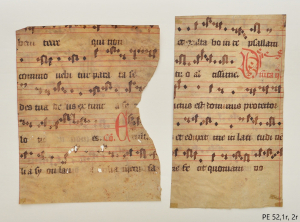Congratulations to our graduates // March 2024
Congratulations!
We would like to congratulate all recent graduates on completing their studies and look forward to welcoming you to the alumni network of the University of Klagenfurt!
We would like to congratulate all recent graduates on completing their studies and look forward to welcoming you to the alumni network of the University of Klagenfurt!
40. Symposium zur Geschichte Millstatts und Kärntens. Hrsg. von Sabine Seelbach. Frank & Timme: Berlin, 2024
The results of the 40th symposium “The History of Millstatt and Carinthia” reflect the region’s rich and varied cultural history. The authors engage with it from various perspectives: landscape, architecture, art, codicology and science history. Their discussions lead from the question whether the Oldenburg (near Spittal) was Carinthia’s largest stronghold to the journey taken by illuminated parchments from Italy to Millstatt, an example of international mediaeval book culture. They prove how prominent texts have been identified with the help of Millstatt parchment fragments, a fact that raises new questions about the literature canon in monasteries. The correspondence between anthropologist Felix von Luschan and Carlo de Marchesetti allows insights into science history around 1900. Very close to contemporary debates is the analysis of Felix von Luschan’s portrait collection, which permits the re-evaluation of anthropological portrait photography of other cultures.
Of particular interest is Ulrich Seebach’s contribution: he talks about his most recent research in Klagenfurt University Library’s parchment fragments, several of which he was able to identify and describe for the first time.

Missale Fragment PE 52
Congratulations to Dmitri Blüschke for being awarded a grant of EUR 442.000 by the Austrian Science Foundation for his project on “Europe’s Mineral Trade and Global Energy Transition Nexus amid Geopolitical Risks”!
Values—whether financial profit or moral and social values such as justice and sustainability—often appear as abstract and intangible. Infrastructure allows us to explore the materiality of seemingly immaterial value.
The special issue “Infrastructures of Value: New and Historical Materialities in Agriculture” (Ethnos – Journal of Anthropology), edited by Christof Lammer (Klagenfurt) and André Thiemann (Prague) shows how infrastructures and practices of infrastructuring shape value of agricultural matter. Ethnographic studies from Australia, China, Moldova, Serbia and Italy examine land’s financialization, terroir wine and its bottles, eco-certification and alternative food networks as well as the interaction between agronomics and cold chains. As material networks, infrastructures facilitate, channel, or hinder circulation—the metamorphoses as well as movement of objects, people, non-human beings and ideas. In doing so, they mediate value: they give actions and their products importance and relevance by materially integrating them into larger wholes. Thereby, this approach brings attention to materiality to David Graeber’s theory of value. The exploration of infrastructures of value thus offers new perspectives for thinking about the production, appropriation and distribution of material wealth.
Table of Contents
Introduction: Infrastructuring Value* by Christof Lammer & André Thiemann
Infrastructures of Farmland Valuation in Australia* by Sarah R. Sippel
Nature’s Value: Evidencing a Moldovan Terroir Through Scientific Infrastructures* by Daniela Ana
Peasant in a Bottle: Infrastructures of Containment for an Italian Wine Cooperative* by Oscar Krüger
Valuing Organics: Labels, People, and the Materiality of Information Infrastructure in China* by Christof Lammer
Infrastructuring ‘Red Gold’: Agronomists, Cold Chains, and the Involution of Serbia’s Raspberry Country by André Thiemann
Infrastructuring Value Worlds: Connections and Conventions of Capitalist Accumulation by Edward F. Fischer
(Articles marked with * are open access.)
Christof Lammer is a social anthropologist and postdoctoral researcher at the Department of Society, Knowledge and Power at the University of Klagenfurt.
Quicklinks

Information for
Address
Your privacy is important to us!
We use cookies to optimally redesign our website and to improve it continuously for you.
Click on the different category headings to view further information and to change the default settings.
Please note that refusing some cookies may affect the way our website works. Web pages may not be displayed correctly and may not function properly.
Reference to processing of your data collected on this website in countries without an adequate level of data protection:
By clicking on "Accept all cookies", you also consent to your data being processed by Google, Facebook, LinkedIn, Twitter and YouTube, including the USA in accordance with Art. 49 (1) sentence 1 lit. a DSGVO.
The European Court of Justice considers the USA to be a country with an insufficient level of data protection according to EU standards.
Essential cookies
These cookies are strictly necessary for the functioning of the website. Essential cookies enable basic functions and are necessary for the proper functioning of the website. You can set your browser to block these cookies or to notify you about these cookies. However, some parts of the website may not work as expected.
These cookies do not store any personal data.
Hiding the cookie notice
Two cookies are required for this setting to be saved. Otherwise this hint will be displayed again every time the page is loaded.
We use tracking and analysis tools to ensure continuous optimisation and needs-based design of our website. Tracking measures also enable us to record statistics regarding the use of our website by visitors and to develop our website further on the basis of these findings.
If you do not want Google and Facebook to track your use of our website and transmit your visits, you can disable tracking in your browser here:
We also use different external services including Google Webfonts, Google Maps, and external video providers.
Since these providers may collect personal data such as your IP address we allow you to block them here.
Please be aware that this might significantly limit the functionality and appearance of our site. Changes will take effect once you reload the page.
Google Webfont Settings:
Google Maps Settings:
Google reCaptcha Settings:
Vimeo and Youtube video embeds:
For further information on the cookies used, please refer to our
Datenschutzerklärungen der Universität Klagenfurt